Ming Yang
Bench-RNR: Dataset for Benchmarking Repetitive and Non-repetitive Scanning LiDAR for Infrastructure-based Vehicle Localization
Sep 19, 2025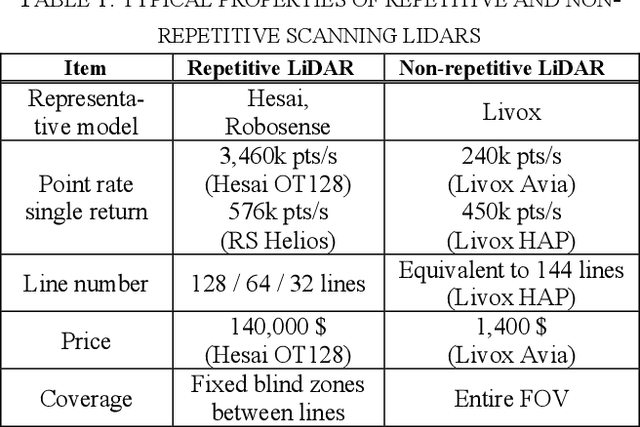
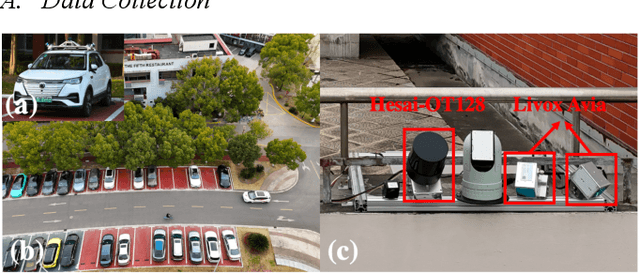
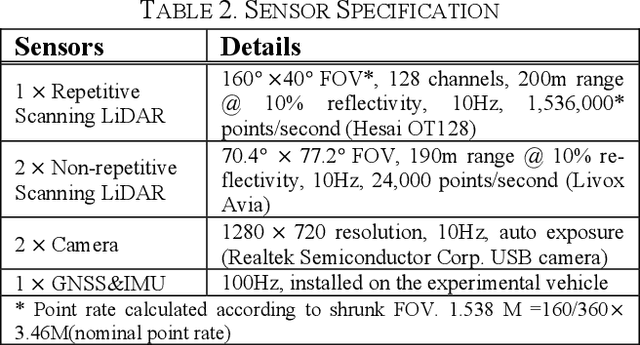
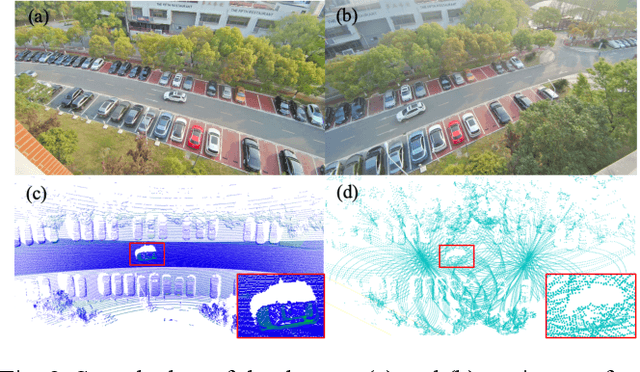
Abstract:Vehicle localization using roadside LiDARs can provide centimeter-level accuracy for cloud-controlled vehicles while simultaneously serving multiple vehicles, enhanc-ing safety and efficiency. While most existing studies rely on repetitive scanning LiDARs, non-repetitive scanning LiDAR offers advantages such as eliminating blind zones and being more cost-effective. However, its application in roadside perception and localization remains limited. To address this, we present a dataset for infrastructure-based vehicle localization, with data collected from both repetitive and non-repetitive scanning LiDARs, in order to benchmark the performance of different LiDAR scanning patterns. The dataset contains 5,445 frames of point clouds across eight vehicle trajectory sequences, with diverse trajectory types. Our experiments establish base-lines for infrastructure-based vehicle localization and compare the performance of these methods using both non-repetitive and repetitive scanning LiDARs. This work offers valuable insights for selecting the most suitable LiDAR scanning pattern for infrastruc-ture-based vehicle localization. Our dataset is a signifi-cant contribution to the scientific community, supporting advancements in infrastructure-based perception and vehicle localization. The dataset and source code are publicly available at: https://github.com/sjtu-cyberc3/BenchRNR.
Choice Outweighs Effort: Facilitating Complementary Knowledge Fusion in Federated Learning via Re-calibration and Merit-discrimination
Aug 25, 2025Abstract:Cross-client data heterogeneity in federated learning induces biases that impede unbiased consensus condensation and the complementary fusion of generalization- and personalization-oriented knowledge. While existing approaches mitigate heterogeneity through model decoupling and representation center loss, they often rely on static and restricted metrics to evaluate local knowledge and adopt global alignment too rigidly, leading to consensus distortion and diminished model adaptability. To address these limitations, we propose FedMate, a method that implements bilateral optimization: On the server side, we construct a dynamic global prototype, with aggregation weights calibrated by holistic integration of sample size, current parameters, and future prediction; a category-wise classifier is then fine-tuned using this prototype to preserve global consistency. On the client side, we introduce complementary classification fusion to enable merit-based discrimination training and incorporate cost-aware feature transmission to balance model performance and communication efficiency. Experiments on five datasets of varying complexity demonstrate that FedMate outperforms state-of-the-art methods in harmonizing generalization and adaptation. Additionally, semantic segmentation experiments on autonomous driving datasets validate the method's real-world scalability.
CasP: Improving Semi-Dense Feature Matching Pipeline Leveraging Cascaded Correspondence Priors for Guidance
Jul 23, 2025Abstract:Semi-dense feature matching methods have shown strong performance in challenging scenarios. However, the existing pipeline relies on a global search across the entire feature map to establish coarse matches, limiting further improvements in accuracy and efficiency. Motivated by this limitation, we propose a novel pipeline, CasP, which leverages cascaded correspondence priors for guidance. Specifically, the matching stage is decomposed into two progressive phases, bridged by a region-based selective cross-attention mechanism designed to enhance feature discriminability. In the second phase, one-to-one matches are determined by restricting the search range to the one-to-many prior areas identified in the first phase. Additionally, this pipeline benefits from incorporating high-level features, which helps reduce the computational costs of low-level feature extraction. The acceleration gains of CasP increase with higher resolution, and our lite model achieves a speedup of $\sim2.2\times$ at a resolution of 1152 compared to the most efficient method, ELoFTR. Furthermore, extensive experiments demonstrate its superiority in geometric estimation, particularly with impressive cross-domain generalization. These advantages highlight its potential for latency-sensitive and high-robustness applications, such as SLAM and UAV systems. Code is available at https://github.com/pq-chen/CasP.
From Experts to a Generalist: Toward General Whole-Body Control for Humanoid Robots
Jun 15, 2025Abstract:Achieving general agile whole-body control on humanoid robots remains a major challenge due to diverse motion demands and data conflicts. While existing frameworks excel in training single motion-specific policies, they struggle to generalize across highly varied behaviors due to conflicting control requirements and mismatched data distributions. In this work, we propose BumbleBee (BB), an expert-generalist learning framework that combines motion clustering and sim-to-real adaptation to overcome these challenges. BB first leverages an autoencoder-based clustering method to group behaviorally similar motions using motion features and motion descriptions. Expert policies are then trained within each cluster and refined with real-world data through iterative delta action modeling to bridge the sim-to-real gap. Finally, these experts are distilled into a unified generalist controller that preserves agility and robustness across all motion types. Experiments on two simulations and a real humanoid robot demonstrate that BB achieves state-of-the-art general whole-body control, setting a new benchmark for agile, robust, and generalizable humanoid performance in the real world.
Active-O3: Empowering Multimodal Large Language Models with Active Perception via GRPO
May 27, 2025Abstract:Active vision, also known as active perception, refers to the process of actively selecting where and how to look in order to gather task-relevant information. It is a critical component of efficient perception and decision-making in humans and advanced embodied agents. Recently, the use of Multimodal Large Language Models (MLLMs) as central planning and decision-making modules in robotic systems has gained extensive attention. However, despite the importance of active perception in embodied intelligence, there is little to no exploration of how MLLMs can be equipped with or learn active perception capabilities. In this paper, we first provide a systematic definition of MLLM-based active perception tasks. We point out that the recently proposed GPT-o3 model's zoom-in search strategy can be regarded as a special case of active perception; however, it still suffers from low search efficiency and inaccurate region selection. To address these issues, we propose ACTIVE-O3, a purely reinforcement learning based training framework built on top of GRPO, designed to equip MLLMs with active perception capabilities. We further establish a comprehensive benchmark suite to evaluate ACTIVE-O3 across both general open-world tasks, such as small-object and dense object grounding, and domain-specific scenarios, including small object detection in remote sensing and autonomous driving, as well as fine-grained interactive segmentation. In addition, ACTIVE-O3 also demonstrates strong zero-shot reasoning abilities on the V* Benchmark, without relying on any explicit reasoning data. We hope that our work can provide a simple codebase and evaluation protocol to facilitate future research on active perception in MLLMs.
Automated Text-to-Table for Reasoning-Intensive Table QA: Pipeline Design and Benchmarking Insights
May 26, 2025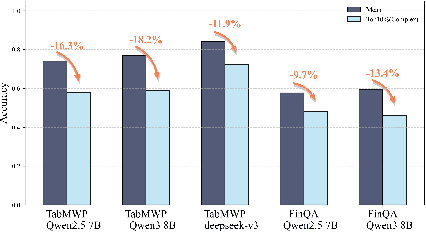

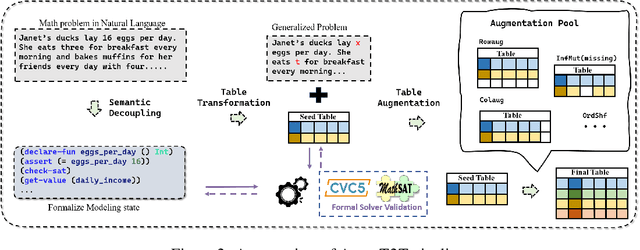

Abstract:Reasoning with tabular data holds increasing importance in modern applications, yet comprehensive evaluation methodologies for reasoning-intensive Table Question Answering (QA) tasks remain nascent. Existing research is constrained by two primary bottlenecks: 1) Reliance on costly manually annotated real-world data, which is difficult to cover complex reasoning scenarios; 2) The heterogeneity of table structures hinders systematic analysis of the intrinsic mechanisms behind the underperformance of LLMs, especially in reasoning-intensive tasks. To address these issues, we propose an automated generation pipeline AutoT2T that transforms mathematical word problems into table-based reasoning tasks, eliminating the need for manual annotation. The pipeline can generate multiple variants of a table for the same reasoning problem, including noisy versions to support robustness evaluation. Based on this, we construct a new benchmark TabularGSM, which systematically spans a range of table complexities and trap problems. Experimental analyses through AutoT2T and TabularGSM reveal that the tight coupling between reasoning and retrieval or identification processes is a key factor underlying the failure of LLMs in complex Table QA tasks. This highlights the necessity for models to develop synergistic reasoning capabilities in order to perform effectively in complex Table QA tasks.
Weather-Magician: Reconstruction and Rendering Framework for 4D Weather Synthesis In Real Time
May 26, 2025Abstract:For tasks such as urban digital twins, VR/AR/game scene design, or creating synthetic films, the traditional industrial approach often involves manually modeling scenes and using various rendering engines to complete the rendering process. This approach typically requires high labor costs and hardware demands, and can result in poor quality when replicating complex real-world scenes. A more efficient approach is to use data from captured real-world scenes, then apply reconstruction and rendering algorithms to quickly recreate the authentic scene. However, current algorithms are unable to effectively reconstruct and render real-world weather effects. To address this, we propose a framework based on gaussian splatting, that can reconstruct real scenes and render them under synthesized 4D weather effects. Our work can simulate various common weather effects by applying Gaussians modeling and rendering techniques. It supports continuous dynamic weather changes and can easily control the details of the effects. Additionally, our work has low hardware requirements and achieves real-time rendering performance. The result demos can be accessed on our project homepage: weathermagician.github.io
GMatch: Geometry-Constrained Feature Matching for RGB-D Object Pose Estimation
May 22, 2025Abstract:We present GMatch, a learning-free feature matcher designed for robust 6DoF object pose estimation, addressing common local ambiguities in sparse feature matching. Unlike traditional methods that rely solely on descriptor similarity, GMatch performs a guided, incremental search, enforcing SE(3)-invariant geometric consistency throughout the matching process. It leverages a provably complete set of geometric features that uniquely determine 3D keypoint configurations, ensuring globally consistent correspondences without the need for training or GPU support. When combined with classical descriptors such as SIFT, GMatch-SIFT forms a general-purpose pose estimation pipeline that offers strong interpretability and generalization across diverse objects and scenes. Experiments on the HOPE dataset show that GMatch outperforms both traditional and learning-based matchers, with GMatch-SIFT achieving or surpassing the performance of instance-level pose networks. On the YCB-Video dataset, GMatch-SIFT demonstrates high accuracy and low variance on texture-rich objects. These results not only validate the effectiveness of GMatch-SIFT for object pose estimation but also highlight the broader applicability of GMatch as a general-purpose feature matcher. Code will be released upon acceptance.
FedSaaS: Class-Consistency Federated Semantic Segmentation via Global Prototype Supervision and Local Adversarial Harmonization
May 14, 2025Abstract:Federated semantic segmentation enables pixel-level classification in images through collaborative learning while maintaining data privacy. However, existing research commonly overlooks the fine-grained class relationships within the semantic space when addressing heterogeneous problems, particularly domain shift. This oversight results in ambiguities between class representation. To overcome this challenge, we propose a novel federated segmentation framework that strikes class consistency, termed FedSaaS. Specifically, we introduce class exemplars as a criterion for both local- and global-level class representations. On the server side, the uploaded class exemplars are leveraged to model class prototypes, which supervise global branch of clients, ensuring alignment with global-level representation. On the client side, we incorporate an adversarial mechanism to harmonize contributions of global and local branches, leading to consistent output. Moreover, multilevel contrastive losses are employed on both sides to enforce consistency between two-level representations in the same semantic space. Extensive experiments on several driving scene segmentation datasets demonstrate that our framework outperforms state-of-the-art methods, significantly improving average segmentation accuracy and effectively addressing the class-consistency representation problem.
JAEGER: Dual-Level Humanoid Whole-Body Controller
May 10, 2025Abstract:This paper presents JAEGER, a dual-level whole-body controller for humanoid robots that addresses the challenges of training a more robust and versatile policy. Unlike traditional single-controller approaches, JAEGER separates the control of the upper and lower bodies into two independent controllers, so that they can better focus on their distinct tasks. This separation alleviates the dimensionality curse and improves fault tolerance. JAEGER supports both root velocity tracking (coarse-grained control) and local joint angle tracking (fine-grained control), enabling versatile and stable movements. To train the controller, we utilize a human motion dataset (AMASS), retargeting human poses to humanoid poses through an efficient retargeting network, and employ a curriculum learning approach. This method performs supervised learning for initialization, followed by reinforcement learning for further exploration. We conduct our experiments on two humanoid platforms and demonstrate the superiority of our approach against state-of-the-art methods in both simulation and real environments.
 Add to Chrome
Add to Chrome Add to Firefox
Add to Firefox Add to Edge
Add to Edge